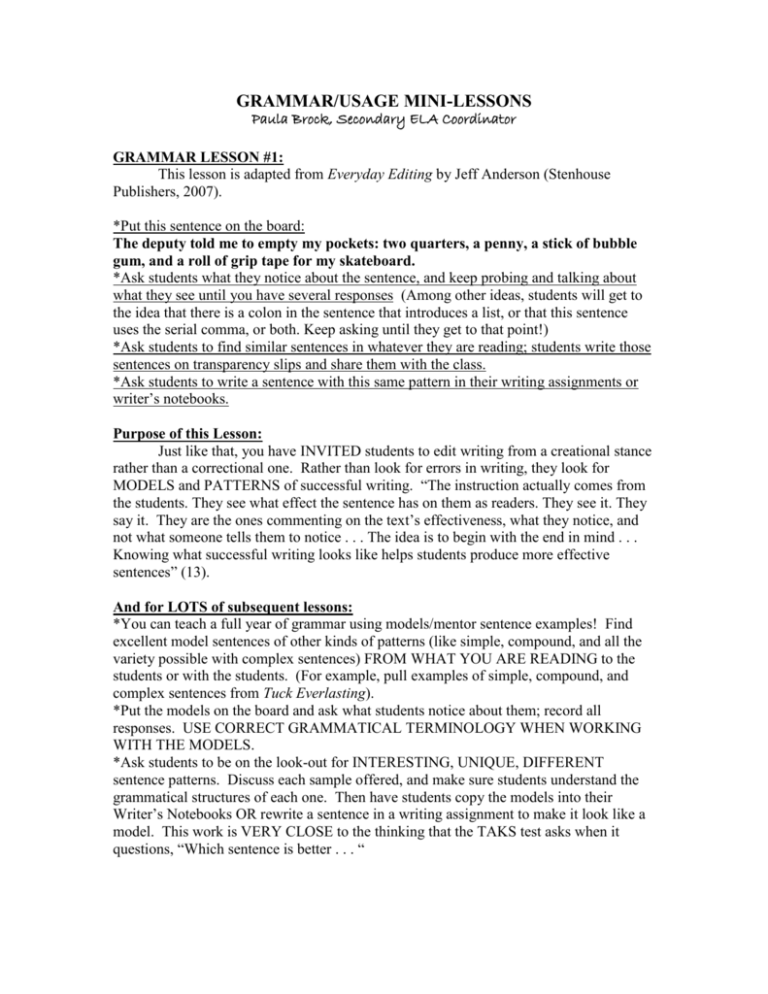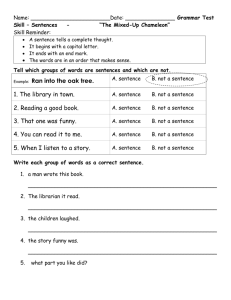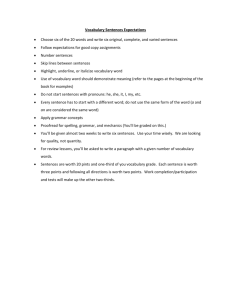GRAMMAR/USAGE MINI-LESSONS
advertisement

GRAMMAR/USAGE MINI-LESSONS Paula Brock, Secondary ELA Coordinator GRAMMAR LESSON #1: This lesson is adapted from Everyday Editing by Jeff Anderson (Stenhouse Publishers, 2007). *Put this sentence on the board: The deputy told me to empty my pockets: two quarters, a penny, a stick of bubble gum, and a roll of grip tape for my skateboard. *Ask students what they notice about the sentence, and keep probing and talking about what they see until you have several responses (Among other ideas, students will get to the idea that there is a colon in the sentence that introduces a list, or that this sentence uses the serial comma, or both. Keep asking until they get to that point!) *Ask students to find similar sentences in whatever they are reading; students write those sentences on transparency slips and share them with the class. *Ask students to write a sentence with this same pattern in their writing assignments or writer’s notebooks. Purpose of this Lesson: Just like that, you have INVITED students to edit writing from a creational stance rather than a correctional one. Rather than look for errors in writing, they look for MODELS and PATTERNS of successful writing. “The instruction actually comes from the students. They see what effect the sentence has on them as readers. They see it. They say it. They are the ones commenting on the text’s effectiveness, what they notice, and not what someone tells them to notice . . . The idea is to begin with the end in mind . . . Knowing what successful writing looks like helps students produce more effective sentences” (13). And for LOTS of subsequent lessons: *You can teach a full year of grammar using models/mentor sentence examples! Find excellent model sentences of other kinds of patterns (like simple, compound, and all the variety possible with complex sentences) FROM WHAT YOU ARE READING to the students or with the students. (For example, pull examples of simple, compound, and complex sentences from Tuck Everlasting). *Put the models on the board and ask what students notice about them; record all responses. USE CORRECT GRAMMATICAL TERMINOLOGY WHEN WORKING WITH THE MODELS. *Ask students to be on the look-out for INTERESTING, UNIQUE, DIFFERENT sentence patterns. Discuss each sample offered, and make sure students understand the grammatical structures of each one. Then have students copy the models into their Writer’s Notebooks OR rewrite a sentence in a writing assignment to make it look like a model. This work is VERY CLOSE to the thinking that the TAKS test asks when it questions, “Which sentence is better . . . “ GRAMMAR LESSON #2: This lesson is adapted from 6+1 Traits of Writing by Ruth Culham, Chapter 6: “Sentence Fluency.” Rather than a single “lesson,” per se, this chapter is a series of important suggestions: “. . . read aloud fine examples of beautifully written texts . . .” [Sounds like Lesson #1, doesn’t it?] “Students should be reading their [own] work aloud.” (179) [Ruth Culham advocates making PVC pipe phones so that students can read their own writing out loud to themselves.] Older students might prefer to just “whisper read” to themselves. “Start with sentences and notice their construction – do they have varied beginnings and lengths?” (181) In other words, ask students to take a look at a piece of writing they are working on (or a journal entry), and see if all their sentences are the same LENGTH and/or START THE SAME WAY. If either is true, ask students to combine or rearrange some of their sentences to achieve more variety. Any of the sample papers (185-194 in Culham’s book) could be used for SENTENCE COMBINING activities. A few short, choppy sentences could be pulled for groups of students to combine into better versions. Students should ALWAYS make notes about their learning activities in their writing notebooks or journals; models of excellent sentences should be included in the notes they make. Writing things down is a way to learn and remember the lessons! GRAMMAR LESSON #3: This lesson (or really a SERIES OF LESSONS) is pulled from Image Grammar by Harry Noden, Heinemann Publishers, 1999. These lessons also make use of MODEL SENTENCES. “ . . . the writer chooses from a repertoire of sentence structures . . . (1) the participle, (2) the absolute, (3) the appositive, (4) adjectives shifted out of order, and (5) active verbs.” Participles (- - start with –ing forms to avoid confusing the –ed form with the verb in a sentence.) Sample sentences: “Hissing, slithering, and coiling, the diamond-scaled snakes attacked their prey.” Or participial phrases: “Hissing their forked red tongues and coiling their cold bodies, the diamond-scaled snakes attacked their prey.” INDIVIDUALLY OR IN TEAMS, STUDENTS FIND OTHER EXAMPLES OF PARTICIPLES/PARTICIPIAL PHRASES IN WHAT THEY ARE READING AND PUBLISH THESE EXAMPLES ON THE BOARD OR ON BUTCHER PAPER, CHART TABLETS, OR SENTENCE STRIPS. Students should copy some of the model sentences into their journals and then try to revise some of their own sentences with participles in something they have written. (-ed and irregular participial forms can be taught when students are SOLID with using -ing participial forms.) Absolutes “Claws digging, feet kicking, the cat climbed the tree.” Or the absolute phrase: “Feet trembling on the snow-covered rocks, the mountain climber edged along the cliff.” FOLLOW THE SAME STEPS AS WERE DONE WITH PARTICIPLES. Adjectives Shifted Out of Order “The large bull moose, red-eyed and angry, charged the intruder.” DITTO ABOVE STEPS. Action Verbs “The gravel road curled around the left side of the barn.” DITTO ABOVE STEPS. One more rich lesson resource follows; I will add to these mini-lessons this year, but this small collection of 4 lessons will help your students ace the TAKS test! Don’t forget: the format is ALWAYS model the lessons together whole class, repeat again in small groups, and finally have students apply the lesson independently - - with LOTS of talk and discussion and explanation throughout! -p GRAMMAR LESSON #4 This lesson is really no lesson at all, but rather a recommendation of a SINGLE resource for a deep and authentic knowledge base for professional development in teaching writing (and really all of ELA). The strength of this resource is that the lessons are naturally DIFFERENTIATED. Carroll, Joyce Armstrong and Edward E. Wilson. Acts Of Teaching – How to Teach Writing, Second Edition. Portsmouth, NH: Heinemann, 2008. Acts of Teaching includes: 19 prewriting strategies An entire chapter on genre and how you can shape (organize) writing 12 sharing (collaborative) strategies Chapters on teaching grammar (commas, capitalization, agreement, spelling), revision (ratiocination, sentence variety, sentence beginnings, sentence sense, and sentence combining), reformulating (paragraphing, 5 examples of functional paragraphs, leads, coherence, and conclusions), correcting (proofreading, editing, publishing, clocking), doing and writing research papers, and writing across the curriculum (reader response, read and retell, dialectical notes, text rendering, text tampering, sequence charts, and Jackdaws). All of these chapters include mini-lessons, research-based strategies, and engaging suggestions for teaching the content.







